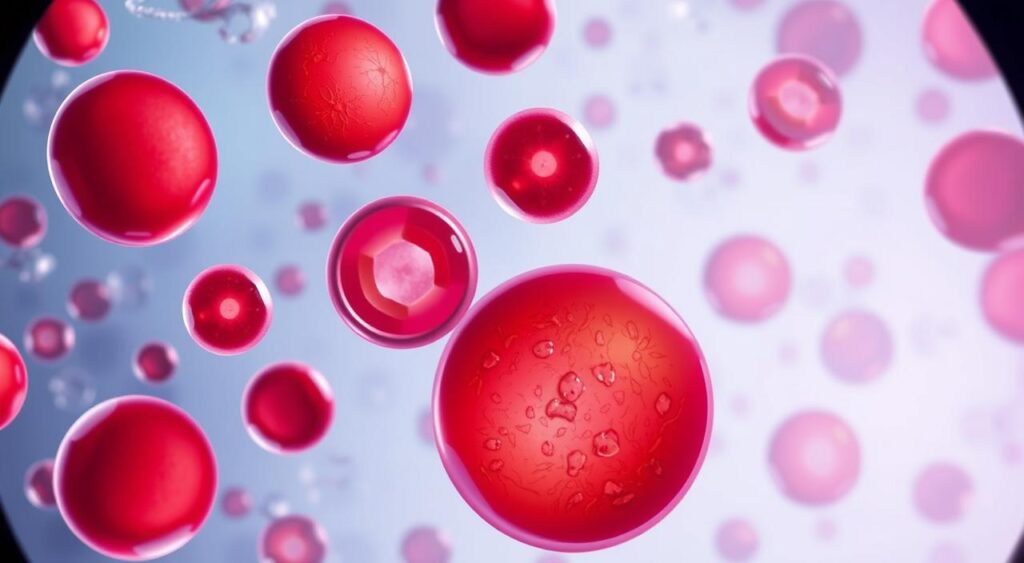Understand the causes, symptoms, and treatment of megaloblastic anemia/macrocytic anemia, a common blood disorder. Learn how to manage this condition and improve your overall health.
The symptoms of megaloblastic anaemia can be very debilitating. It’s crucial to explore this condition in depth.

Megaloblastic anaemia is a complex condition with various causes. These include dietary deficiencies and genetic disorders. Understanding these causes is key to developing a good treatment plan.
By learning about the symptoms and causes of megaloblastic anaemia, individuals can take control of their health.
Key Takeaways
- Megaloblastic anaemia affects a significant portion of the population.
- Understanding the causes of megaloblastic anaemia is crucial for effective management and treatment.
- The symptoms of megaloblastic anaemia can be debilitating, making prompt medical attention essential.
- Dietary deficiencies, particularly a lack of vitamin B12, can contribute to the development of megaloblastic anaemia.
- Recognizing the symptoms of megaloblastic anaemia is vital for initiating treatment and preventing long-term complications.
- Exploring treatment options, including dietary modifications and supplementation, can help individuals manage megaloblastic anaemia and improve their quality of life.
Understanding Megaloblastic Anemia
Megaloblastic anemia is a condition where red blood cells are too big and don’t work right. It happens when the body lacks vitamin B12 or folate. These are key for making healthy red blood cells. Doctors use physical checks, medical history, and lab tests to diagnose it.
People with megaloblastic anemia might feel tired, weak, and have trouble breathing. If not treated, it can cause serious problems like heart issues and brain damage. Knowing the causes and symptoms is important for quick diagnosis and treatment.
What is Megaloblastic Anemia?
Megaloblastic anemia is a type of anemia where red blood cells can’t divide and grow right. This usually happens because of a lack of vitamin B12 or folate. These are needed for DNA production and healthy red blood cell development.
Types of Megaloblastic Anemia
There are two main types: vitamin B12 deficiency and folate deficiency. Vitamin B12 deficiency is the most common. It can be due to not enough vitamin B12 in the diet or problems with absorption in the gut.
How it Affects the Body
Megaloblastic anemia can really affect the body. It can cause tiredness, weakness, and shortness of breath. If not treated, it can lead to serious issues like heart problems and brain damage. Getting a diagnosis is key for quick treatment and avoiding long-term health issues.
| Causes of Megaloblastic Anemia | Symptoms |
|---|---|
| Vitamin B12 deficiency | Fatigue, weakness, shortness of breath |
| Folate deficiency | Headache, dizziness, pale skin |
Common Causes and Risk Factors
Megaloblastic anemia happens when the body lacks red blood cells or they don’t work right. It can be caused by not getting enough nutrients, trouble absorbing them, or certain health issues. A big reason is a lack of vitamin B12, which can come from not eating enough of it or not being able to absorb it well.
Some common risk factors for megaloblastic anemia include:
- Age: Older adults are more likely to develop megaloblastic anemia due to decreased stomach acid production, which can lead to poor absorption of vitamin B12.
- Dietary habits: A diet that is lacking in essential nutrients, such as vitamin B12 and folate, can increase the risk of developing megaloblastic anemia.
- Medical conditions: Certain medical conditions, such as celiac disease and Crohn’s disease, can increase the risk of developing megaloblastic anemia.
It is essential to note that megaloblastic anemia can be treated and managed with proper medical care and dietary changes. Knowing what causes megaloblastic anemia and its risk factors helps people take steps to avoid it. Eating well and managing health issues can prevent vitamin B12 deficiency and other types of megaloblastic anemia.
Being aware of megaloblastic anemia’s causes and risk factors helps people protect their health. They can take steps to lower their risk of getting the condition.
| Cause | Risk Factor | Description |
|---|---|---|
| Dietary deficiencies | Lack of vitamin B12 and folate | A diet that is lacking in essential nutrients can increase the risk of developing megaloblastic anemia. |
| Absorption problems | Certain medical conditions | Certain medical conditions, such as celiac disease and Crohn’s disease, can increase the risk of developing megaloblastic anemia. |
| Medical conditions | Age and dietary habits | Older adults and individuals with certain dietary habits are more likely to develop megaloblastic anemia. |
Vitamin B12 Deficiency and Its Impact
Vitamin B12 is key for making red blood cells. Without enough, you can get megaloblastic anaemia. This can cause tiredness, weakness, and even brain problems.
To avoid this, eating foods rich in B12 is important. These include meat, fish, and dairy. But, some people might not absorb B12 well. This can lead to health issues like pernicious anemia.
Dietary Sources of B12
- Meat
- Fish
- Dairy products
- Eggs
Absorption Problems
Many things can cause trouble absorbing B12. This includes pernicious anemia, celiac disease, and Crohn’s disease. These issues stop the body from getting enough B12.
Pernicious Anemia
Pernicious anemia stops the body from absorbing B12. It happens when you don’t have enough intrinsic factor. This protein is needed for B12 absorption. Without it, you can face serious health problems.
| Condition | Symptoms | Treatment |
|---|---|---|
| Vitamin B12 deficiency anaemia | Fatigue, weakness, neurological problems | B12 supplements, dietary changes |
| Pernicious anemia | Fatigue, weakness, neurological problems | B12 supplements, dietary changes |
The Role of Folate Deficiency
Folate deficiency is a key factor in megaloblastic anaemia. This condition makes red blood cells too big. Folate, a B vitamin, is vital for making red blood cells. Without enough, you can get folate deficiency anaemia.
To prevent this, it’s important to eat well and consider supplements. A balanced diet and supplements can help avoid folate deficiency anaemia.
Causes of folate deficiency include poor diet, some medicines, and health issues. Knowing these causes helps prevent folate deficiency anaemia. Eating foods high in folate, like leafy greens and legumes, is a good start.

- Consume a balanced diet rich in folate
- Avoid certain medications that can interfere with folate absorption
- Manage underlying medical conditions that may contribute to folate deficiency
By taking these steps, you can lower your risk of folate deficiency anaemia and megaloblastic anaemia. This promotes your overall health and well-being.
Recognizing the Symptoms of Megaloblastic Anemia
Megaloblastic anemia affects how red blood cells are made. It causes symptoms that can be mild or serious. Knowing the symptoms is key to managing megaloblastic anemia. Symptoms can be split into early signs and more serious ones.
Early signs include feeling tired, weak, and short of breath. These symptoms might seem minor at first but can get worse if not treated. More serious symptoms include pale or yellowish skin and problems like numbness in hands and feet.
Early Warning Signs
- Fatigue and weakness
- Shortness of breath
- Headaches and dizziness
Advanced Symptoms
- Pale skin and yellowish skin
- Neurological problems such as numbness and tingling in the hands and feet
- Diarrhea and loss of appetite
If you notice any of these symptoms, get medical help right away. Early treatment can prevent serious problems and improve management of megaloblastic anemia. Doctors can diagnose it with blood tests and physical checks.
By spotting the symptoms of megaloblastic anemia and getting medical help, you can get the right treatment. This improves your health and well-being.
| Symptom | Description |
|---|---|
| Fatigue and weakness | Mild to severe fatigue and weakness that can worsen over time |
| Shortness of breath | Difficulty breathing or feeling winded even when sitting still |
| Pale skin and yellowish skin | Noticeable paleness or yellowish discoloration of the skin |
Diagnosis and Testing Methods
To find out if someone has megaloblastic anaemia, a megaloblastic anaemia diagnosis is key. This means doing blood tests and physical checks. These steps help find the cause of the condition, guiding the treatment for megaloblastic anaemia.
Tests like these are used to spot megaloblastic anaemia:
- Complete Blood Count (CBC)
- Blood smear
- Vitamin B12 and folate level tests
These tests show how serious the condition is. They help doctors plan the best treatment for megaloblastic anaemia. Getting a correct megaloblastic anaemia diagnosis is vital for a good recovery.
Treatment Options and Approaches
Megaloblastic anaemia needs quick treatment to avoid serious problems and improve life quality. The main goal is to fix the cause, which is often a lack of vitamin B12 or folate. To manage megaloblastic anaemia well, you need to change your diet, take supplements, and make lifestyle changes.
Vitamin B12 Supplementation
Getting enough vitamin B12 is key for treating megaloblastic anaemia caused by a lack of it. You can take it by mouth or get shots, depending on how bad the lack is.
Folate Therapy
Folate therapy is also very important for managing megaloblastic anaemia, especially if you’re low on folate. Folate supplements can help lessen symptoms and boost blood cell making.
Dietary Modifications
Changing your diet is crucial for managing megaloblastic anaemia. Eating foods full of vitamin B12 and folate, like leafy greens, fruits, and fortified cereals, can help symptoms and support health.
By taking a full approach to managing megaloblastic anaemia, you can handle your condition better and lower the chance of serious problems. It’s very important to work with a healthcare provider to make a treatment plan that fits your needs and helps you feel better overall.
Prevention and Lifestyle Changes
To lower the risk of megaloblastic anaemia, focus on prevention through diet and lifestyle. Eating foods high in vitamin B12 and folate is key. This can help avoid complications from megaloblastic anaemia.
It’s important to eat lean meats, fish, and poultry. Also, choose fortified cereals and dairy products. Avoiding certain medicines and substances can help too.
Dietary Recommendations
- Eat foods rich in vitamin B12, such as lean meats and fish
- Include folate-rich foods, such as leafy greens and legumes, in your diet
- Choose fortified cereals and dairy products to support vitamin B12 intake
Risk Reduction Strategies
Regular check-ups with your doctor are crucial. They can spot risks early and prevent complications. Making smart lifestyle choices can help prevent megaloblastic anaemia.

By eating well and living healthily, you can lower your risk of megaloblastic anaemia. This supports your overall health and wellbeing.
Living with Megaloblastic Anemia
Managing megaloblastic anaemia needs a full plan. This includes megaloblastic anaemia management and stopping megaloblastic anaemia complications. You can do this with medical care, lifestyle changes, and diet.
Some important things to know about living with megaloblastic anemia are:
- Regular blood tests to check on the condition
- Following a strict treatment plan, like vitamin B12 and folate therapy
- Eating a healthy diet full of important nutrients
- Staying away from things that make it worse
By sticking to these tips and working with your doctor, you can manage megaloblastic anemia well. This helps avoid problems and makes life better.
Megaloblastic anemia is a long-term condition. Keeping up with megaloblastic anaemia management is key to avoiding megaloblastic anaemia complications. With the right care and support, people with this condition can live full and happy lives.
| Aspect of Management | Importance |
|---|---|
| Regular Blood Tests | High |
| Adherence to Treatment Plan | High |
| Healthy Diet | Medium |
| Avoiding Triggers | Medium |
Conclusion
Megaloblastic anemia is a complex condition that needs a detailed management plan. Understanding its causes and symptoms is key. Seeking medical help quickly is crucial for those affected.
Managing megaloblastic anemia effectively means tackling its root causes. This could be a lack of vitamin B12 or folate. By making dietary changes, taking supplements, and working with doctors, patients can improve their health.
Recovering from megaloblastic anemia can be tough, but there’s hope. Recent advances in treatment mean better outcomes. With the right care and self-care, those affected can regain their energy and enjoy life again.
FAQ
Q: What is megaloblastic anemia?
A: Megaloblastic anemia is a condition where the body lacks vitamin B12 or folate. This leads to the creation of large, dysfunctional red blood cells called megaloblasts.
Q: What are the common causes of megaloblastic anemia?
A: The main reasons for megaloblastic anemia are a lack of vitamin B12 and folate. These can come from not getting enough in your diet or problems absorbing them.
Q: What are the symptoms of megaloblastic anemia?
A: Symptoms include feeling very tired, weak, and pale. You might also have shortness of breath, an irregular heartbeat, headaches, and numbness in your hands and feet.
Q: How is megaloblastic anemia diagnosed?
A: Doctors use blood tests to check for vitamin B12, folate, and red blood cell size. They might also look at your bone marrow.
Q: How is megaloblastic anemia treated?
A: Treatment usually involves taking vitamin B12 and/or folate supplements. This can be through pills or injections, depending on your needs.
Q: Can megaloblastic anemia be prevented?
A: Yes, by eating a balanced diet with enough vitamin B12 and folate. Also, managing any health issues that might lead to deficiencies can help prevent it.
Q: What are the potential complications of untreated megaloblastic anemia?
A: Untreated megaloblastic anemia can cause serious problems. These include neurological issues, heart problems, and a higher risk of infections.
Q: How can megaloblastic anemia be managed long-term?
A: Long-term management involves regular checks on vitamin B12 and folate levels. You’ll need to keep taking supplements as needed and address any underlying health issues.
